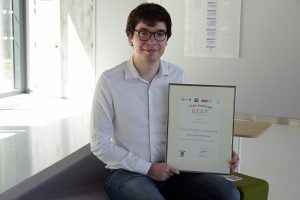On 6th april 2018, Samuel Leleu has defended his thesis. Awarded by the University of Toulouse, his work was supervised by both CIRIMAT laboratory (CNRS/UT3 Paul Sabatier/INP), the Science de la Matière doctoral school, and IRT Saint Exupéry.The high quality and the relevance of Samuel’s thesis contributed to get significant results as a part of SURFINNOV project. THESIS SUBJECT “Toward a new “green” and efficient corrosion[…]
Victor Dos Santos, third year PhD student at the IRT Saint Exupéry, got the first place of the GEET Doctoral School Congress Contest which took place at Jean Jaures University Blagnac IUT, 5th of April. The GEET Doctoral School Congress Contest allowed PhDs to present their thesis works in the field of electrical engineering, electronics and telecommunications.Four others[…]
On 6th march 2018, Pierre Roumanille has defended his thesis. Awarded by University of Toulouse III – Paul Sabatier, his work was supervised by both CIRIMAT laboratory (CNRS/UT3 Paul Sabatier/INP), the Science de la Matière doctoral school, and IRT Saint Exupéry. The high quality and the relevance of Pierre’s thesis contributed to get significant results[…]
The IRT Saint Exupéry has sponsored the 9th European Congress ERTS2 with a booth to present its activities in Intelligent Systems & Data and Systems Engineering. Two papers have been also presented as well as two session chairs. The 9th European Congress ERTS2 on Embedded Real Time Software & Systems took place in Toulouse (France) from January 31st to February 2nd. This[…]
On 26th january 2018, Léonard Serrano has defended his thesis. Awarded by University of Toulouse III – Paul Sabatier, his work was supervised by both Institut Clément Ader laboratory (CNRS/UT3 Paul Sabatier), the MEGEP doctoral school, and IRT Saint Exupéry.The high quality and the relevance of Léonard’s thesis contributed to get significant results as a part of COMPINNOV TD project. THESIS SUBJECT “Epoxy Systems –[…]
On 22th decembre 2017, Lucie Bres has defended her thesis. Awarded by University of Toulouse III – Paul Sabatier, her work was supervised by both LAPLACE laboratory (CNRS/INP-ENSEEIHT/UT3 Paul Sabatier), the GEET doctoral school, and IRT Saint Exupéry.The high quality and the relevance of Lucie’s thesis contributed to get significant results as a part of SURFINNOV project. THESIS SUBJECT “Interaction between a cold atmospheric[…]
On friday, December 22th 2017, Anne Castelan has defended her thesis. Awarded by University of Toulouse III – Paul Sabatier, her work was supervised by both LAPLACE laboratory (CNRS/INP-ENSEEIHT/UPS), the GEET doctoral school and IRT Saint Exupéry. The high quality and the relevance of Anne’s thesis contributed to get significant results as a part of[…]
On wednesday, December 13th 2017, Alexandre Giraud has defended his thesis. Awarded by INP Toulouse, his work was supervised by both LAPLACE laboratory (CNRS/INP-ENSEEIHT/UPS), the GEET doctoral school and IRT Saint Exupéry. The high quality and the relevance of Alexandre’s thesis contributed to get significant results as a part of INTEGRATION project. THESIS SUBJECT «[…]
On tuesday, December 13th 2017, Chaimae Ghfiri has defended her thesis. Awarded by INSA, her work was supervised by both LAAS CNRS laboratory, the GEET doctoral school and IRT Saint Exupéry. The high quality and the relevance of Chaimae’s thesis contributed to get significant results as a part of ROBUSTESSE project. THESIS SUBJECT « Development[…]
IRT Saint Exupéry was partner of the 3rd edition of the 2017 Conference on Big Data from Space (BiDS’17) held from 28 to 30 Nov. at Toulouse. It was co-organised by ESA, the Joint Research Centre of the European Commission, and the European Union Satellite Centre (SatCen) and hosted by the CNES. This conference has brought[…]


